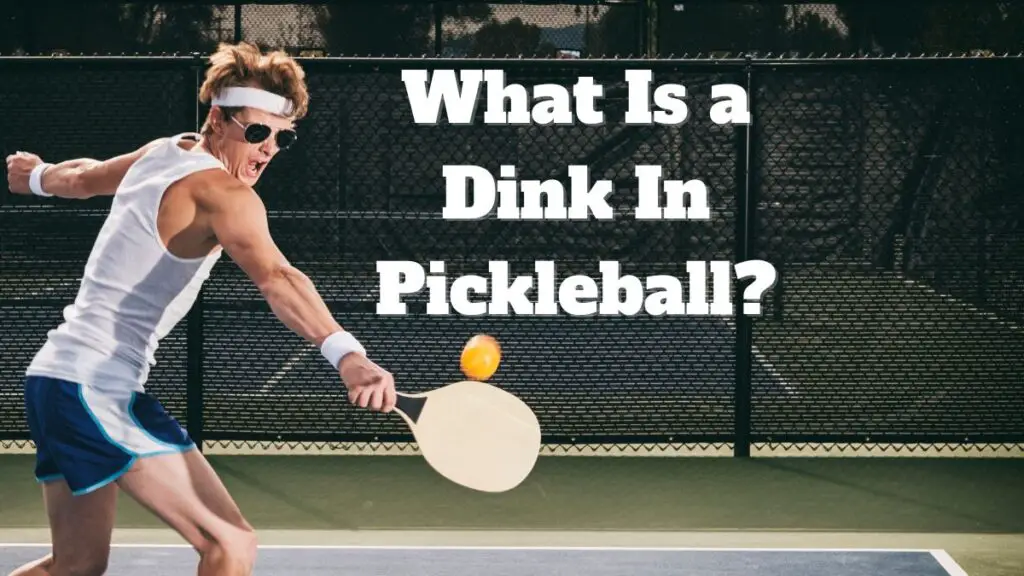If you want to succeed in pickleball, then you need to be able to master the dink shot. But, what is a dink in pickleball?
A dink is when you hit the ball into the opponent’s no volley zone. Basically, the ball is going to be hit exceedingly close to the net. A dink can be one of the toughest shots to return in the game when hit at the right time.
Let’s go into a bit of depth on this. We are itching to tell you what dinking in pickleball is and how you can master that dink shot.

What Is a Dink In Pickleball?
If you play pickleball, you will know that the court is split into multiple zones. The zone closest to the net is known as the no volley zone. You will likely find this abbreviated as NVZ.
As the name suggests, a ball cannot be volleyed from the NVZ. This means that when an opponent has to return a ball from this area, they are limited in the shots they can take.
A dink shot is any shot that is hit into this NVZ. These shots tend to have quite a high trajectory and then fall sharply. In most cases, they are going to force the opponent to move out of position.
As a final note here, a dink shot is only ever hit from the kitchen in pickleball. If you hit a shot similar to a dink outside of the kitchen, then this is known as a drop shot.
Dink Technique
A dink shot can be pretty easy to make but very tough to master. Cross-court dinks are probably the easiest to make.
When you make a dink shot, you want the ball to go over the net and land as close to the net as possible. The closer the dink is to the net, the harder it is to return.
The easiest technique to master follows this process:
- Keep the paddle face open.
- Hit the ball with the paddle in front of your body.
- You want the paddle to lift the ball at a steep angle. This will allow it to fall quickly when it gets to the opponent’s side of the court.
- The movement should be coming from your shoulder and be very soft and controlled. You don’t want to hit that ball too hard; otherwise, you will miss the opportunity to hit that dink.
It is important to remember that the dink has to be soft. If it is too hard, the ball will bounce quite hard, allowing your opponent to return the ball to you.
When you are first getting started with dinking, we suggest that you work on the cross-court dink. Due to the way that the pickleball net is shorter in the middle, it is a much easier shot to hit. Although, of course, if you really want to catch your opponent off guard when you are playing pickleball, you will want to try and get that ball landing on the side of the court that you hit it from. In most cases, this will force your opponent out of position.
When To Dink
This is something that you will learn as you start to play the game more.
Firstly, we want to point out that you will probably not win a point with a dink shot. Your opponent will know how to reach dinks in time. The only time that you stand a chance of winning a point with a dink is if your opponent is too far away from the ball when you hit it.
A series of dink shots will likely come near the end of a rally. The object is to keep hitting dinks into the opponent’s NVZ. The more dinks you hit, the more chance your opponent has of making a mistake, particularly if you are able to hit the ball close to the net on the opponent’s side.
Read more on rally here: What Is a Rally In Pickleball?
Eventually, your opponent will make a mistake, which is going to make it ridiculously easy for you to make a return shot and score a point (or at least gain the serve, if you are using traditional pickleball scoring)
We suggest that you start your dinking when your opponent is on the far end of the court. You are going to want to force them up to the net so you can rush that rally to its conclusion.
When Not To Dink
If your opponent seems to have control of the game, then you would tend to avoid dinking. This is because you don’t want them to force you into a position where you are caught in a dinking rally.
You should also avoid dinking if you are not that close to the net. Remember, your opponent has a limited ability to return that shot to you. This means that if you are far away from the net, you may not be able to reach it in time.
Finally, if you are close to the net but your opponent is on the baseline, try to avoid dinking. It is much easier to score a point if you can keep your opponent on the baseline than to score points from a dinking rally.
You may have to adjust the strategy a little bit as you play. However, we can assure you that, eventually, you will learn when you should avoid dinking. A lot of it is going to be based on your own talents.
Conclusion
Dinking is one of the most important techniques in pickleball. Games can be won based on a good dinking rally. Early on, you should learn how to nail those dinks. If you can, then you have a much better chance of being able to wear out your opponents. If you wear them out, you have a good chance of forcing a mistake and gaining a point.




